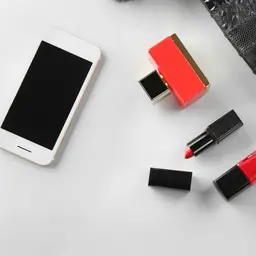
Decryption applications are all the rage. And for good reason, in a single gesture, they make it possible to lift the veil on the composition of everyday products. While this promise of transparency is enthusiastically welcomed by consumers, the cosmetics industry is denouncing the dissemination of sometimes erroneous information. The FEBEA (French Federation of Beauty Companies) has therefore decided to fight back by organizing a press workshop in order to examine beauty applications and disentangle the true from the false.
During this press meeting, Anne Dux, Director of Scientific and Regulatory Affairs at FEBEA, presented five applications. She had chosen the platforms most known by consumers and she deciphered them in order of popularity.
Yuka
This food decoding application aunched its cosmetic version in July 2018 and includes nearly 120,000 beauty products.
Thanks to the vote of nearly 107,000 Internet users, it obtains a score (food and beauty sector combined) of 4.7/5 on the download platforms.
Yuka recognizes the products by scanning the barcode and classifies the ingredients into four categories:
• High risk
• Moderate risk
• Low risk
• No risk
This notion of risk depends on four effects identified by the application: endocrine disruptor, allergen, irritant or carcinogen.
The scoring method is based on the analysis of the product’s ingredient list.
It assesses the impact of products on health, but not their effectiveness, and promises that it will soon propose alternatives: products considered healthier than those that the consumer has scanned. It then gives a score (out of 100) to the product and a comment (poor, bad, good or excellent).
INCI is translated into French for the consumer.
QuelCosmetic
Launched in March 2018 by the UFC Que-Choisir consumer association, this application received a score of 4.6 for 11,900 user votes.
It lists 119,000 skin care products and is only dedicated to the decoding of cosmetics.
It also recognizes the products by the barcode and classifies the ingredients as follows:
• Significant risk
• Medium risk
• Limited risk
• No risk identified
The new version of QuelCosmetic now distinguishes between four different categories of users:
• Babies
• Pregnant women
• Children/adolescents
• Adults
Thus, the application rates the product according to the consumer profile for which it is intended. Filters can be used and the application offers substitute products.
InciBeauty
Launched in November 2017, this application lists less than 10,000 products and scores 4.2/5 with 131 user votes.
It recognizes products by barcode and classifies ingredients into several categories:
• Controversial, at risk
• Not so good
• Satisfactory
• Good
It gives a score out of 20 to the products, gives the number of ingredients in each category, comments on the cosmetics analysed and proposes alternative solutions. Note that this is the only application on which you can find advertising.
Clean Beauty
Created in January 2017, it ranks 4th among the most popular decryption applications with a score of 4.1/5 awarded by 122 Internet users.
Clean Beauty works differently from the others because it is not interested in the barcode but only in the INCI list thanks to a character recognition system.
It indicates the presence of potential endocrine disrupters, preservatives of concern, comedogenic or irritant agents, nanomaterials and 26 fragrance allergens.
It also provides a glossary of nearly 800 ingredients.
Cosmethics
This is the oldest application, since it was launched in February 2016.
It obtained a score of 4.1/5 according to the vote of 10 Internet users.
Cosmethics references 120,000 products.
Like other applications, it operates on a barcode recognition system. On the other hand, it is the only one to offer a configuration system that clearly indicates whether the consumer wishes to avoid a particular substance.
It displays four different signals to distinguish ingredients:
• Personalized alert
• Risk of toxicity
• Potential allergy
• Safe
In addition, the application offers 11 lists of ingredients to avoid.
The dysfunctions pointed out by the FEBEA
While on paper these applications are virtuous, in practice they pose several problems for FEBEA.
Inconsistencies between applications
“We had fun analyzing the same dermocosmetic product with different applications,” Anne Dux explained. “With Yuka, the product obtains a score of 13/100 and is rated high risk because it contains sunscreens. QuelCosmetic considers the product to be good, INCI Beauty gives a score of 10.2 due to the presence of three”not so good” ingredients, five satisfactory and 21 good, Clean Beauty indicates that there is no allergen detected, nor controversial ingredient and finally Cosmethics informs that the care does not present any danger. So, for the same cosmetic, the ratings diverge… “
Barcode recognition
According to Anne Dux, using barcodes to analyze a product’s formula is not a viable method. “Indeed, for the same barcode, it is possible to have two or even three formulas of the same product on the market,” she explained.
Commonly known as EAN 13 code, it is actually intended to transmit information to distributors such as product weight, packaging size, volume, weight and pallet size.
Thus, when the formula of a cosmetic changes, the new INCI list is immediately indicated on the pack but the EAN 13 code remains the same. At least for a period of three to six months, which is the time required for distributors to update new barcodes. “When you scan an EAN code, you don’t actually know which formula you are calling. The first time we used Yuka on a cosmetic, we found that the application showed the presence of Isobutylparaben, an ingredient that has been banned for four years now,” says Anne Dux. “Knowing that this is a laboratory known for its seriousness, I doubt it has put on the market a product containing an ingredient that has been banned for four years!”
However, the Regulatory Director indicated that FEBEA is currently working with distributors to ensure that the EAN code is updated each time the formula is changed.
The limits of the scan of the INCI list
For applications that use graphic recognition software, FEBEA points out “the limitations of using this system with small cylindrical products and others for which the human eye does not read the list of ingredients well.”
The databases
To find out the INCI list associated with the barcode, applications use different sources.
“Most recently, Yuka used Open Beauty Facts, a participatory database accessible to all, on which consumers enter the list of ingredients. Currently, this is no longer the case,” Anne Dux said.
QuelCosmetic proceeds in a different way since it has built its database from products added by consumers, but entered and validated directly by UFC Que-Choisir.
The teams themselves enter the ingredient lists internally.
When consumers try to scan a product that is not referenced on the application, they have the option to send a photo of the pack and the INCI list to QuelCosmetic staff. “Whatever the model of construction of the database, its problem is the updating”, Anne Dux analysed.
With nearly 800,000 cosmetic products on the market, a third of which change formulations every year and 10% of new products, it is indeed complicated to integrate the most recent information into databases.
The questioning of ingredients
Consumers associate three risks in terms of cosmetic products:
• Irritation
• Allergy, which is less frequent and often confused with irritation
• Endocrine disruption
“It is important to remember that the regulatory framework for these ingredients is extremely rigorous. I am used to saying that European cosmetics regulation is the safest in the world. Any substance incorporated into a cosmetic shall be subject to a safety assessment by a safety assessor before it is placed on the market. Ingredients that are implicated or that are particularly sensitive, namely colorantss, preservatives and UV-filters, are evaluated by independent European experts and are genuinely subject to a marketing authorisation. The Cosmetics Regulation came into force on 11 July 2013. Five years later, the schedules of the Regulations (which list restricted ingredients) have been changed more than 70 times, which shows how things are moving towards ever greater safety,” Anne Dux said.
Confusion between hazard and risk
Finally, the main problem that FEBEA faces with cosmetic applications is the fact that they confuse the notions of risk and hazard.
“If you walk in the savannah and meet a lion, it’s dangerous. On the other hand, if the lion is in a cage, it is absolutely not risky,” Anne Dux illustrated.
Indeed, each substance is tested so that the threshold (percentage) at which it has adverse effects can be determined. Under no circumstances may the limit authorised in cosmetics exceed this threshold. And, in order to have a real margin of safety, the Regulations provide that the concentration of an ingredient should be allowed only one hundredth of the dose that causes no effect.
The FEBEA explained that, as applications do not have access to the percentages of ingredients present in the formulas, they cannot assess the real risk, and therefore only take into account the intrinsic hazard of the substances.
Mea Culpa
No one can deny that if these tools are successful, it is because they meet a need for transparency expressed by consumers.
“Although we have the safest regulations in the world, the cosmetics industry is responsible for this climate of mistrust,” Anne Dux admitted.
The fault is the incomprehensible INCI lists, the lack of transparency, the lack of explanation of ingredients to consumers…
Applications replicate
Following this workshop, CosmeticOBS contacted certain publishers of the incriminated cosmetic applications.
Yuka
“Yuka has never used the Open Beauty Facts database. We created our own database from the start and have never worked with them before, but on Yuka, the reliability of the information on cosmetics is very good because each ingredient list is checked manually. We also work with many brands, both small and large, who provide us directly with their product information, and Yuka now offers all brands a solution to update their data as soon as there is a change in composition. Regarding the scientific basis, each ingredient analysis is based on scientific and reliable sources: we have decided to display them in the application in the next update so that it cannot be used as an argument by brands to defend themselves from making products with controversial substances. The brands are hidden behind the fact that these substances are allowed by law. But the fact that ingredients are allowed in Europe does not mean that they are safe: we know that it takes years and dozens of studies before a controversial substance is banned. The fact that the research is still ongoing does not preclude warning about what has been published to date and informing about the potential risks already identified in initial studies and analyses. We really want to apply the precautionary principle on this subject and not wait decades for a controversial substance to be banned,” says Julie Chapon, co-founder of Yuka.
QuelCosmetic
Olivier Andrault, project manager at UFC-Que Choisir, gives several answers to the arguments put forward by the FEBEA. “Our mission is to overcome the slowness of the European process, which can take years to implement the scientists’ recommendations in cosmetics regulation. We cannot wait for substances to be banned to alert consumers to the potential toxicity of certain ingredients. Regarding the documentation of our application, QuelCosmetic relies only on the scientific opinions of recognized bodies, in particular the National Agency for the Safety of Medicines and Health Products (ANSM) at national level, the Scientific Committee for Consumer Safety (CSSC) at European level and the International Agency for Research on Cancer (IARC) at international level,” defends Olivier Andrault. “Our application is not intended to demonize manufacturers, but to help consumers make their choices. Secondly, it is also a way of accelerating the improvement of formulas that we can see are already being implemented by many manufacturers. Indeed, for a long time, manufacturers had no incentive in this direction since no one was able to decipher lists of incomprehensible compositions, this is no longer the case today, thanks to the immediacy offered by these applications.”
Clean Beauty
Candice Colin, co-founder of the Clean Beauty application, also reacts and denounces the amalgams of which her tool is a victim.
“The application was developed by a team of scientists led by a Doctor of Cosmetology Pharmacy according to a rigorous methodology. It only provides scientifically documented information on ingredients that are controversial in the scientific community. Moreover, it is now the only mobile application that does not rate products. It does not refer to any product database. So there can be no mistake about the composition,” she replied. “If the European Cosmetics Regulation is today the most stringent cosmetics regulation in the world, it excludes each year some ingredients that were in the regulatory sense of the term considered quite safe a few weeks before their ban.”
Can we expect a rapprochement between the positioning of applications and the cosmetics industry when everyone is developing arguments that seem so irreconcilable? Instead, we could move towards a real arm wrestling match, which FEBEA seems ready to engage.
“These tools can be improved. We have or will meet with all the editors of these applications to share with them all our specific criticisms. For the time being, we are in a policy of openness and dialogue. We do not question the legitimacy of the applications, but the misleading and unverified information that may appear in them. If things do not evolve in a way that seems to us to be the fairest, the FEBEA will not hesitate to take legal action,” concluded Margaux de Bodard, of the FEBEA’s legal department.
Applications may only have the choice of reed: fold… or break.













